.com pieces
The .com pieces are a series of pieces I started in early 2013 which are centered around snare drum feedback and form/memory as composi(/improvisa)tional material. So far I have finished two of them, iminlovewithanothergirl.com (for snare, microphone and DMX lights) and ialreadyforgotyourpussy.com (for amplified wind instrument and amplified snare). The third and final .com piece is in the sketching stages and is as of yet untitled.
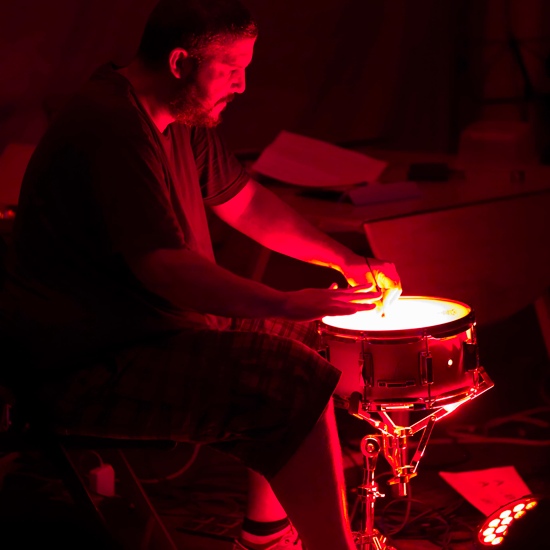
photo by Nick Rutter
///////////////////////////////////////////////////////////////////////////////////////////////////////////////////////////////////////////////////////////////////////
iminlovewithanothergirl.com
Before I go into explaining the thinking behind iminlovewithanothergirl.com here is the most recent studio recording filmed in early 2015:
Click here to read about the recording of the full length studio version above.
In iminlovewithanothergirl.com I wanted to confront some of the more general questions I had about the processes of creating music as a performer/composer/improviser/luthier. Specifically, what benefit would come from writing something down for myself to later read and reinterpret on an instrument, especially if that instrument is unpredictable and difficult to control? The whole middle part of this process seemed useless when you were responsible for each part of the process.
As part of this I wanted to explore a playing technique that I came across while on a tour of solo drums + electronics. During one performance I discovered that I could musically control feedback by placing a condenser mic directly on the head of a snare drum and varying the angle at which the microphone touched the head. The technique of using a microphone as a microscope or to create feedback is nothing new, but the microscopic scale of movement allowed for a dynamic and expressive performance style. The proximity of the microphone to the head also allowed for friction as a means of actuation. These two approaches, feedback and friction, became the sonic basis for iminlovewithanothergirl.com.
Here is the performance in which I first discovered this playing technique. (It appears that I was trying to remove the microphone and its clip from the drum to do something else with them, but I could not move the clip and instead decided to use the microphone in a handheld manner.)
[KGVID]/wp-content/uploads/2015/09/girl_proto.mp4[/KGVID]
I decided that I was going to use improvisation as the starting point for the compositional process and from there I wanted to take on what had become a large compositional concern for me—why compose at all?
The question is simultaneously more complex and simpler than it would initially seem. An obvious answer is the creation of specific material, although improvisation as a means of generating material doesn’t necessarily mean that the generated material is any less specific, or more generic. Synchronicity and intricate orchestration are also considerations, but these are non-issues in a solo context. (I would later develop the idea of synchronicity in an improvised context further with the dfscore system). So two of the main things I could immediately think of were not applicable at all in the context of this piece.
The longest part of the compositional process of this piece was spent considering that very question. I considered several concepts to use as the conceptual foundation of the piece, such as using geographic/iconographic movements on the drum, or using a software-assisted intervention in the process, but dismissed these as they were not central to the question/concern. I wanted to tackle this problem head on, and the solution that I finally came to was to use form as content.
The approach is not dissimilar to John Coltrane‘s compositional process in A Love Supreme where he was also “working on approaches to the problem of writing for a group [of improvisers]” (Porter 2000). Coltrane’s solution was to let the nature of the songs (or concept in my case) determine the material that was played. I adhered to this idea of having a skeletal formal framework with no content prescribed as a general approach in iminlovewithanothergirl.com.
This framework produces an overall shape or form that can have some perceptual coherency, but leaves me, as an improviser, free to generate and manipulate the actual material contained therein. This is similar to the open works of Stockhausen and Boulez, described by Umberto Eco as “examples of ‘open’ works and ‘works in movement'” that “have latent characteristic which guarantees that they will always be seen as ‘works’ and not just as a conglomeration of random components” (Eco 1962). There is an explicit collaboration in the works he refers to where the composer “seems to hand them on to the performer more or less like the components of a construction kit”, although in the .com pieces, the composer and performer are the same person (Eco 1962).
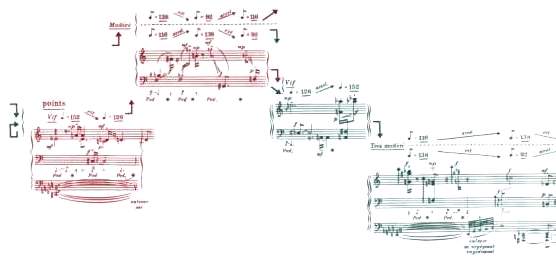
from Third Piano Sonata by Pierre Boulez
For the specific material I would precompose, I limited myself to three formal sections: A, B, and C; and two transition types: sudden and transformation. I later introduced some variation and modifiers to the A/B/C blocks, such as discrete phrases (A1/A2/A3), multiple simultaneous layers, and time directionality. I did not want to exhaust these kinds of modifiers and create a piece that was about a kind of formal saturation, but the inclusion of these few modifications gives the formal blocks/containers some nuance that would not otherwise be present.
I then started a rigorous process, conceived in some conversations with my supervisor (Pierre Alexandre Tremblay) about the idea(s), where I would work on the piece every day. I would begin by composing a few pages worth of formal materials, and then I would record myself performing them, testing out their formal interest and performative challenges. I would also record myself freely improvising with a focus on exploring different sounds and performance techniques so that I could find new approaches without needing to worry about formal considerations. I would then critically listen to all of these recordings, reflecting on what I heard. Finally I would repeat the process the next day, modifying the pages I had composed and composing new ones based on the discoveries made the previous day(s).
After several days of this I developed several insights. One was the basic microscopic nature of the sounds and their gestural language. Since most of the physical gestures and movements used in the piece are small, it led me to overlook some of the finer details of the sounds I was creating. Like the tiny crinkles and crackles of the drumhead as I drag my fingernails across the head or the shifts in acoustic “filtering” depending on the angle and position of the microphone. Listening back to the recordings shortly after performing them helped reduce the perceptual cognitive dissonance I was experiencing.
The second insight, which had conceptual and performative ramifications in the Battle pieces as well as my improvisation in general, was a tendency to want to “paint the walls” with contrast between formal sections. Going in to an improvisation knowing that I would have A, B, and C sections, I would initially tend to make the distinction between sections extreme in an attempt to differentiate the materials as much as possible. The contrast and shifts in material could be more subtle and nuanced, something that I developed over this period. Conceptually, this also helped with pieces like Everything. Everything at Once. Once. where the pieces didn’t have to (and shouldn’t!) be a survey of all the sounds possible with a fixed set of instruments.
This feedback cycle formed a crucial part of the compositional process where I was simultaneously expanding my feedback/friction vocabulary as a performer and then exploring its implementation within the formal constraints as a composer.
Here are a couple examples of the sketches I created during this process, which eventually became pages 10 and 9 of the score:
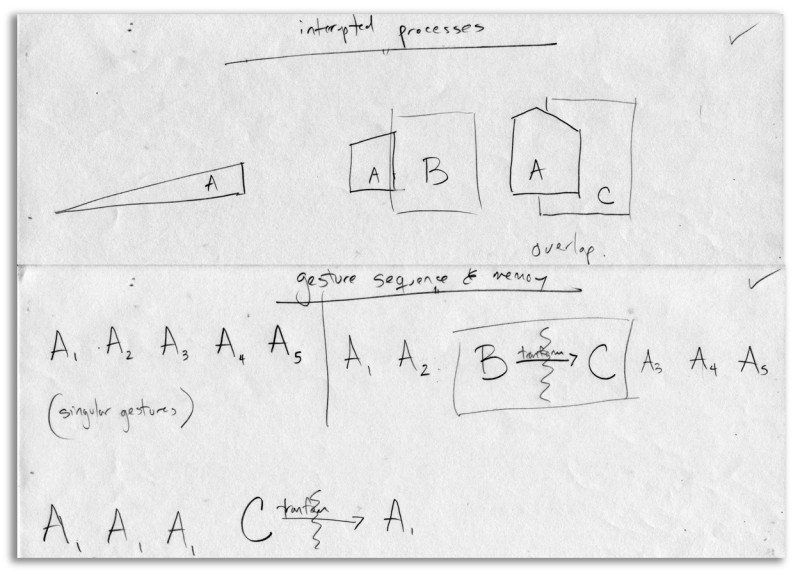
Here is an example of an exploratory free improvisation:
Here are some of the pages from the finished score, which I tried to make look as neutral as possible. (download the full score to see the legend)
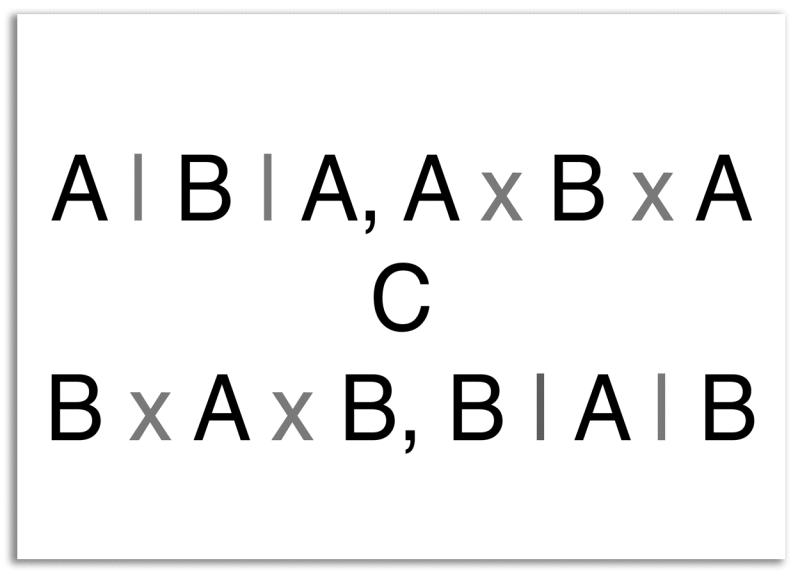
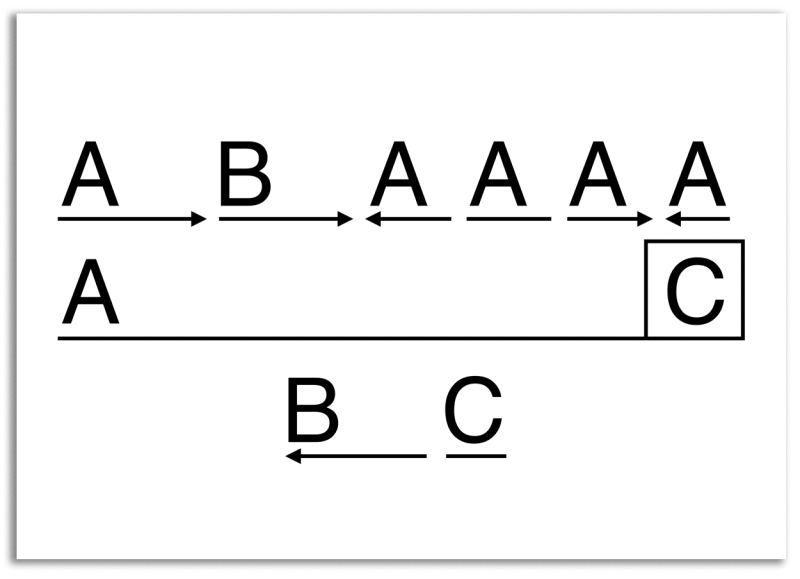
Here is page 10 from the score along with a recording made during the compositional/testing process:

One aspect of the work which is not immediately obvious from an aesthetic or compositional perspective is the challenge of generating material and negotiating the complex formal structures with it. This etude-like challenge is something that shows up in several of my pieces and is central to the performing of this piece. This tension, sometimes bordering on confusion, is similar to Christian Wolff‘s music where the performer is put in a situation where “the perplexity of recognizing the situation one is in and working out a solution there and then” can lead to confused silence (Chase and Thomas 2010).
This challenge is extended into memory where physicality, which can often aid memory in percussion music, is greatly diminished in the piece due to the manner in which the snare is played. Steven Schick, in his book The Percussionist’s Art, mentions the importance of physical memory when memorizing percussion music with his “heavy reliance on kinetic memory” where memories “are loaded with kinetic information, each consisting of trained and reliable physical reflexes” (Schick 2011). Although iminlovewithanothergirl.com is for snare drum, the friction-based method of playing, microscopic movements, and somewhat unpredictable nature of feedback mean that physical movement is not explicitly tied to sound production and therefore is not a meaningful hook to which one can attach memory. This is particularly apparent in page 9 of the score, which deals with a sequence of individual gestures one after the other.
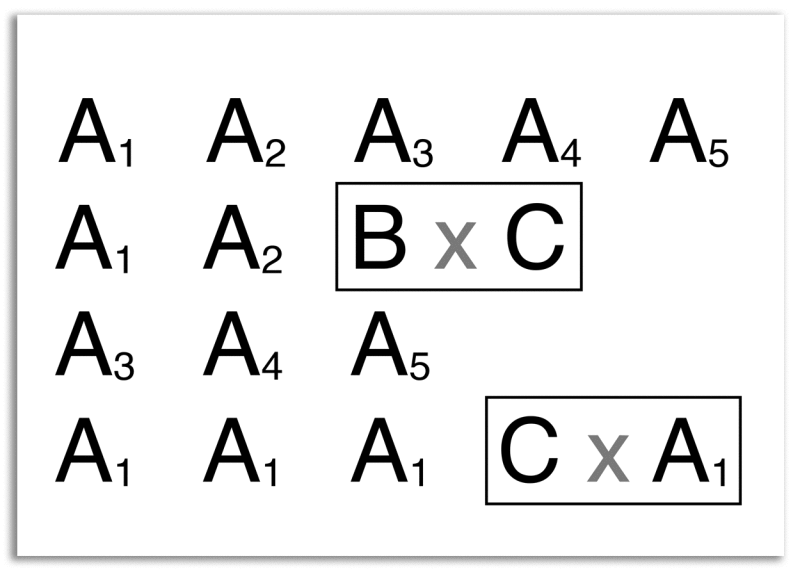
Schick goes on to give a detailed account of his memorization process, which involves the “juggling” of memory chunks, where older sets of material are refreshed by bringing them into the foreground between the learning of new chunks of material. Although neither of these techniques, using physical memory and shuffled/staggered chunk rehearsal, apply to the performance of iminlovewithanothergirl.com, they were present during the compositional/developmental stages of the piece.
The overall large-scale form of the piece takes inspiration from long-form comedy theatre improvisation. Long-form comedy improv traditionally involves many short scenes which are interrelated in some way, be it by themes, characters, or story (Halpern 1994). One long-form comedy piece or structure is called a Harold. A Harold has many variants but is primarily composed of three groups of three scenes, A/B/C, which are interspersed with improv games. The three scenes are transformed each time they return by either displacing them in time, location or context. A Harold typically begins with an arbitrary seed given by the audience and ends in a mesh of the themes, characters and stories developed up to that point (Halpern 1994).
The specific implementation of a Harold in iminlovewithanothergirl.com can be seen in the structure page of the score. It is scaled down slightly, to a 2×3 (instead of the typical 3×3) form, as a Harold can typically last between 45 minutes to an hour, and the sonic material of the piece would become exhausting for that length of time. The piece still begins with purely improvised material and each page, or beat to use Harold lingo, is interspersed with other improvised material.
The three sections labeled as “Improvisation” in the score serve different functions. The opening “Free Improvisation” is exploratory and is meant to generate material for use throughout the piece, a sort of instant exposition. The second “Improvisation” is meant to function as a palate cleanser, resetting the perceptual memory space of both the performer and the audience. The final “Improvisation” is a summative attempt to incorporate and contextualize all the material developed throughout the performance. Much like in comedy improv, any given performance can fail to make any of these connections, producing a flat form that may be aesthetically pleasing but lacking in formal interest.
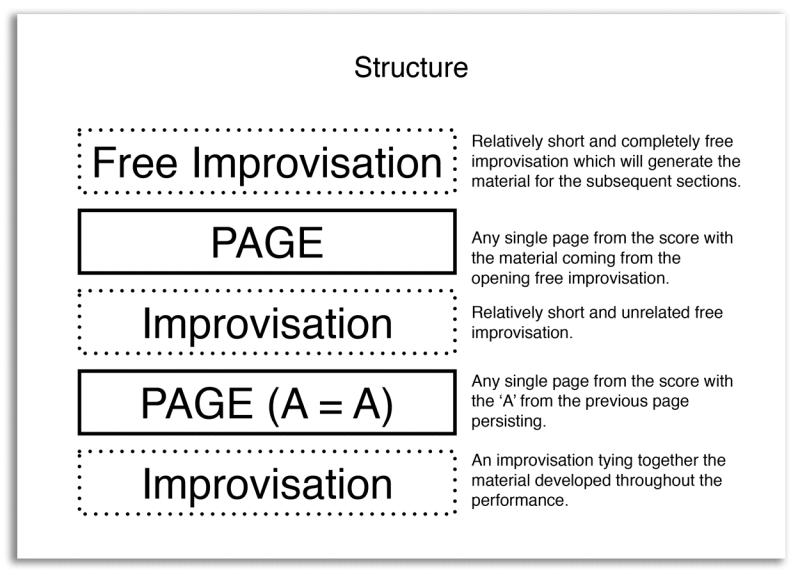
When the piece is performed live I lay the pages randomly on the floor around me so I can view all of them at once and move from page to page freely.
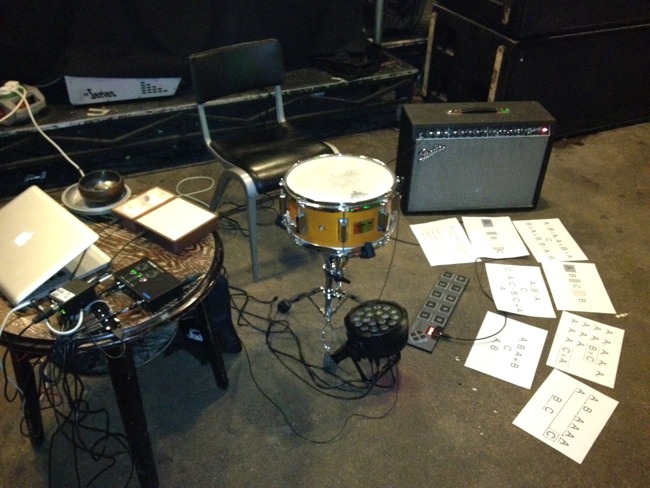
Here is a live performance filmed at Kammer Klang in 2014:
The visual component of the piece developed independently of the compositional process. I had been developing a DMX light-based system for use in a collaborative performance art group which focused on controlling DMX lights with a computer in a performance context. When I decided to make a video documenting some of the playing techniques I had developed for iminlovewithanothergirl.com, I decided to incorporate the DMX light setup. I chose to use blindingly bright red lights, and I mapped their brightness to the amplitude of the microphone. The simplicity of this mapping and the close-angle filming exaggerates the violence of the sound world used in the piece. The use of shadows in particular, although minimized in the studio videos due to the tightness of the shooting angle, adds a second layer of visual focus with the interaction between the illuminated performer and the shadows they create. Depending on the viewing angle this can produce a “misled perception”, a visual language similar to Marian Zazeela‘s The Magenta Lights, in which objects and shadows interact in a manner which creates multiple optical illusions (Duckworth 1997).
Here is the first video recording of what would eventually become iminlovewithanothergirl.com showing the lighting setup:
This is what the lighting setup looks like during the studio recordings. In addition to the light below the snare, there is an additional light illuminating the snare from the side:

Alongside the feedback/snare/DMX version of the piece, I envisioned the piece being useful as a general improv etude. Here is page 9 from the score along with a recording of Sam Andreae performing it on tenor saxophone. As a perceptual experiment, try to see if the A3 that starts the 3rd line is the same as the A3 in the first line.

///////////////////////////////////////////////////////////////////////////////////////////////////////////////////////////////////////////////////////////////////////
ialreadyforgotyourpussy.com
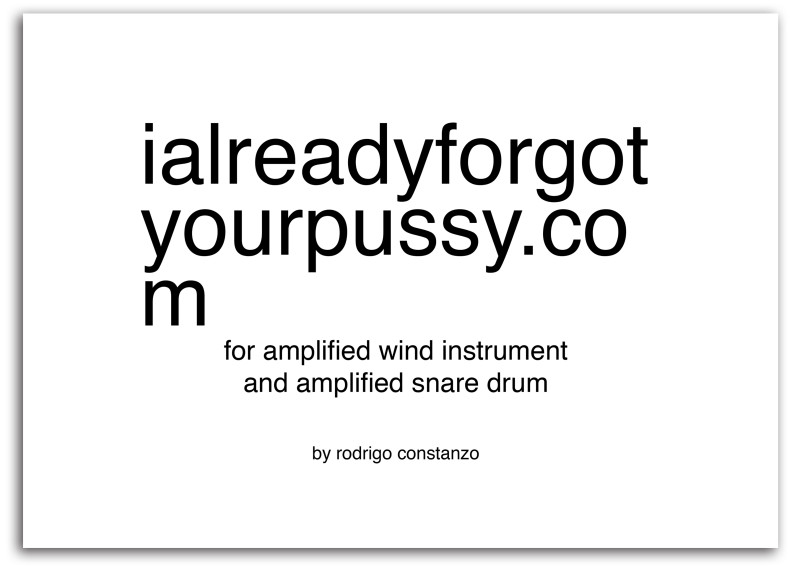
The second .com was written for/with flautist Richard Craig after discovering that we had both been exploring similar sound worlds (instrument + feedback). That spawned a collaboration that ended up producing Amp/AL, an album by Richard which I recorded in late 2013.
Here is ialreadyforgotyourpussy.com from that album:
I wanted to re-approach the sonic and compositional world of iminlovewithanothergirl.com, but for a duet. This required some fundamental changes in how form and time worked in the piece. In iminlovewithanothergirl.com the performer is free to move from section to section (A/B/C) and page to page. That structural freedom would not work for two performers, as it would be difficult to move through material synchronously while retaining the “block form” iminlovewithanothergirl.com. A different approach altogether would be required.
Here is a video from one of our first meetings where we tested different sound worlds and interactions:
The main compositional focus moved from form as content to memory as content. Memory functions as the prime compositional material, both defining the type of material which persists into a new section as well as transforming that material once it is recalled. The emphasis on memory as a formal marker also changes the general function of form in the piece. The formal markers (A/B/C) in iminlovewithanothergirl.com were conceived as blocks of material which can contain internal development. In ialreadyforgotyourpussy.com each memory exists as a pivot point, or pivot cue as defined by Zorn (Zorn 1999). There is no implicit formal block to adhere to, only the shift in material, which serves as the formal content in the piece.
The memory space of the piece is a multidimensional one. Memories can be defined as 1) physical: what one is literally doing, 2) aural: the literal sound of something, and 3) interaction: the relationship between the two performers. This multidimensional space is difficult to navigate as a performer, adding to and expanding on the etude-like nature of iminlovewithanothergirl.com. Separating the different memory types can be especially confusing with physical and aural memories as these are coupled on most instruments. Physically recreating the same movements on most acoustic instruments will lead to the same, or at least a very similar, sound being produced. The unpredictable nature of a feedback-based instrument means that recreating a physical movement can produce a wildly different sonic result. During an interview conducted during the Amp/AL recording session Richard commented that it was difficult “to delineate [aural] from physicality”, although separating aural from pitch, in a general sense, “gave [him] more room” to play with (Craig 2013).
The transformative aspect of logging and recalling different types of memories gives the piece a complex formal structure where material is returned to, but is intrinsically transformed by the very act of recollection, a parallel with how memory actually works within the brain (Snyder 2001). The duet context of the piece further complicates the matter as the interaction memory type is based on what both performers were doing, which can then be logged/recalled by just one performer, potentially radically transforming the context of the original interaction.
The idea of taking material or memories and transforming them was inspired by the ear system in John Zorn‘s Cobra. In Cobra a conductor holds up cue cards when any performer signals for one to be called. These cards contain a variety of prompts or modifiers that are applied to the music being collectively improvised. I have given several workshops on and have conducted Cobra many times, and I find the ear system to be one of my favorite aspects of it. The ear system deals specifically with change, or transformation.

From Cobra by John Zorn
Although Zorn has “deliberately chosen not to publish” the score, there are some notes and instructions compiled by people who have performed the piece with Zorn (Cox and Warner 2004).
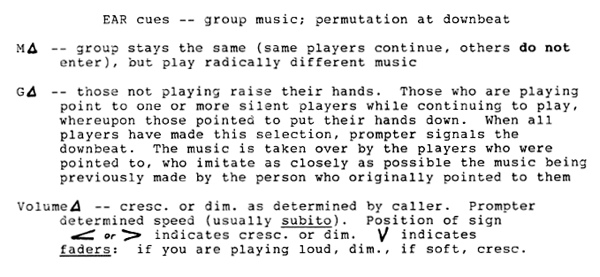
From Cobra by John Zorn
Rehearsing and recording ialreadyforgotyourpussy.com was incredibly difficult, as memories began to bleed into each other after two or more run-throughs. There is a saturation that begins to take over which is complicated since the memories stored are nearly always recalled as long-term memories, while the performer has to engage in echoic and short-term memory spaces on a smaller scale. It seems that current research agrees with this saturation, where there are physiological limitations in how these types of memories interact with one another, primarily in terms of which type of memory is consciously (foreground) and unconsciously (background) available (Snyder 2001).
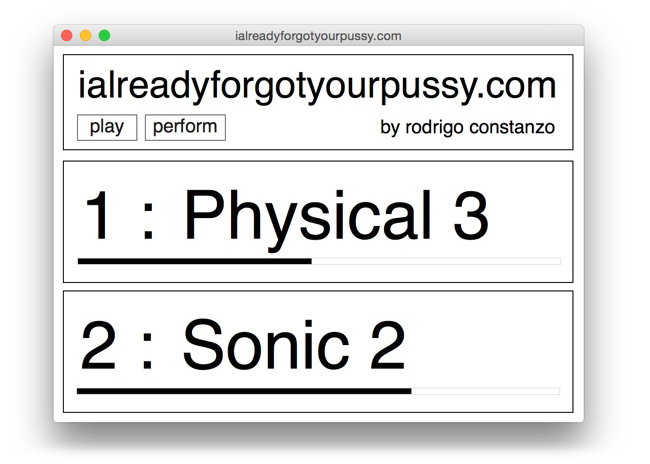
When I initially conceived the piece I did not know how to best notate it, or how to present the information to the performers. I verbally explained the piece to Richard and we discussed how the mechanism of logging/recalling memories would work. Since the piece was based on memory, I wanted to decouple the ability to log and recall memories from the performer. I also wanted the improvised material to flow naturally, with the performers only concerned with the small and medium-scale passing of time and not trying to prepare or “cherry pick” memories.
I wanted to implement a notation which was unfixed, dynamic, adaptive, and transparent to the performer. Having begun development a few months before on the dfscore system, a real-time dynamic networked score system, I realized that this piece would be a perfect usage of the system. I created a streamlined and simplified version of the interface and it was used during the Amp/AL recording. The score was later adapted to work on iPads running Cycling74’s MIRA application, making it much easier to perform in a live context.
As mentioned above, the ability to log and recall memories is decoupled from the performer. The dynamic score gives the performer only two seconds warning before a new memory is introduced, and gives no indication whether the memory being displayed is to be logged (the first time it is presented) or recalled (any subsequent time). This was a conscious decision from a compositional/programming perspective. Keeping track of potentially nine separate memories is difficult and is part of the challenge of the piece.
Unlike iminlovewithanothergirl.com there are no transition types defined in ialreadyforgotyourpussy.com. There are two main reasons for this. The first is that each performer’s score is generated independently so that new memories arrive asynchronously, meaning that transitions would rarely happen together which as such could end up sounding like part of a general material development. The second is that since the piece is a duet, I wanted there to be a more contextually flexible way to move from memory to memory, putting more emphasis on the judgement of Richard and myself.
Several rehearsals of the piece were needed to refine the timing engine of the score producing patch. My initial idea of each section having a random duration between 20 and 120 seconds proved to create sections much longer than I wanted. At that time scale, improvisational development tends to begin, which blurs the function of memory and form in the piece. The duration I chose in the end was between 10 and 60 seconds, but rather than being determined randomly, I applied a Gaussian distribution to the selection of the duration. The distribution itself is initialized randomly and changed to a new random value after between two and twelve memories have been produced. This weighted randomness is crucial as it allows each individual performance to develop a formal shape, but at the same time the performer cannot predict and become comfortable with the upcoming memory durations.
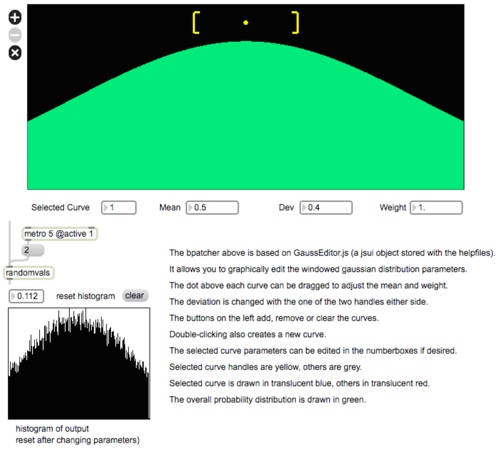
The weighted randomness used in ialreadyforgotyourpussy.com. From help file for randomvals by Alex Harker.
Here is a live performance of ialreadyforgotyourpussy.com at the Amp/AL launch party at a Distractfold concert.


